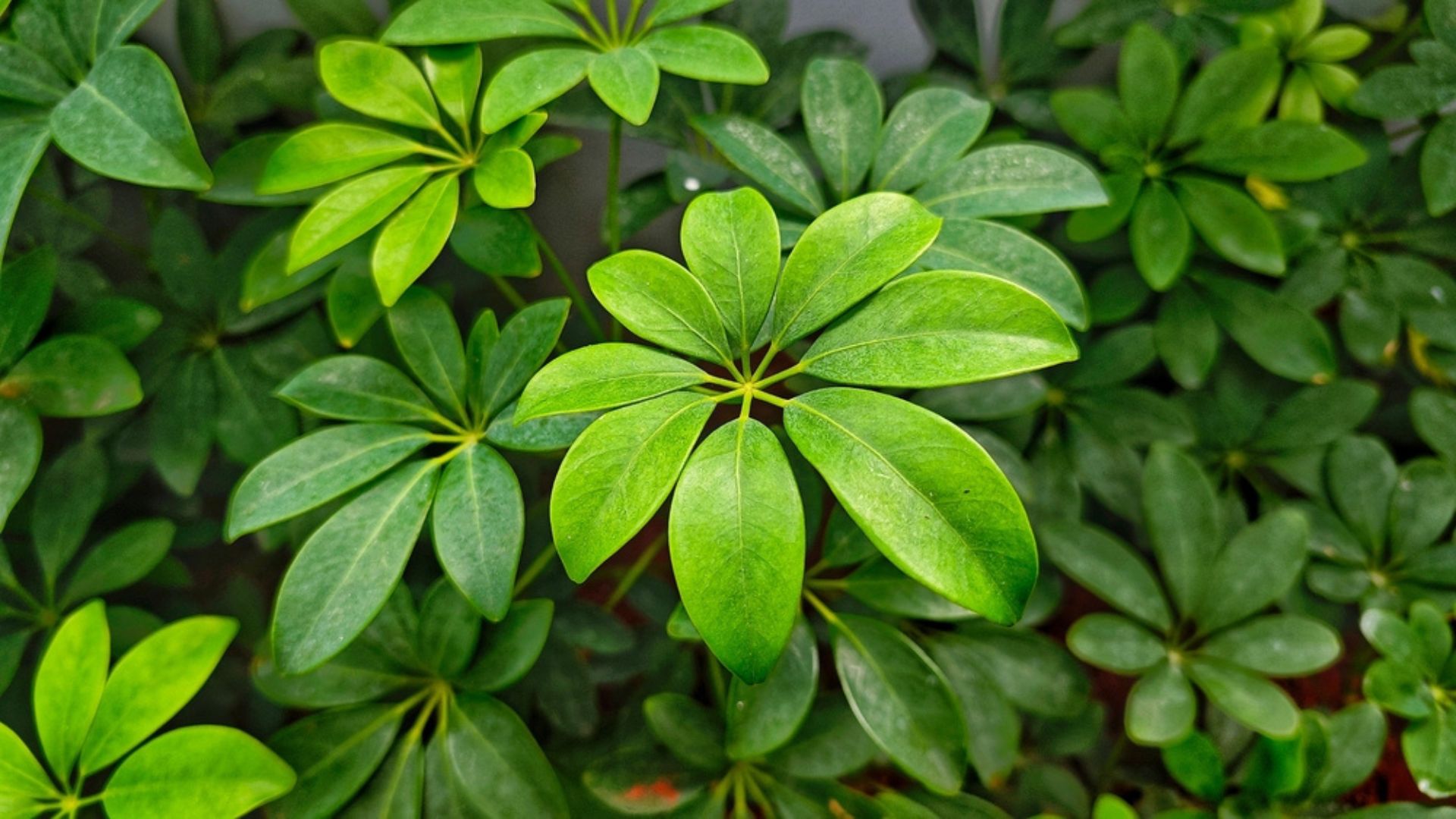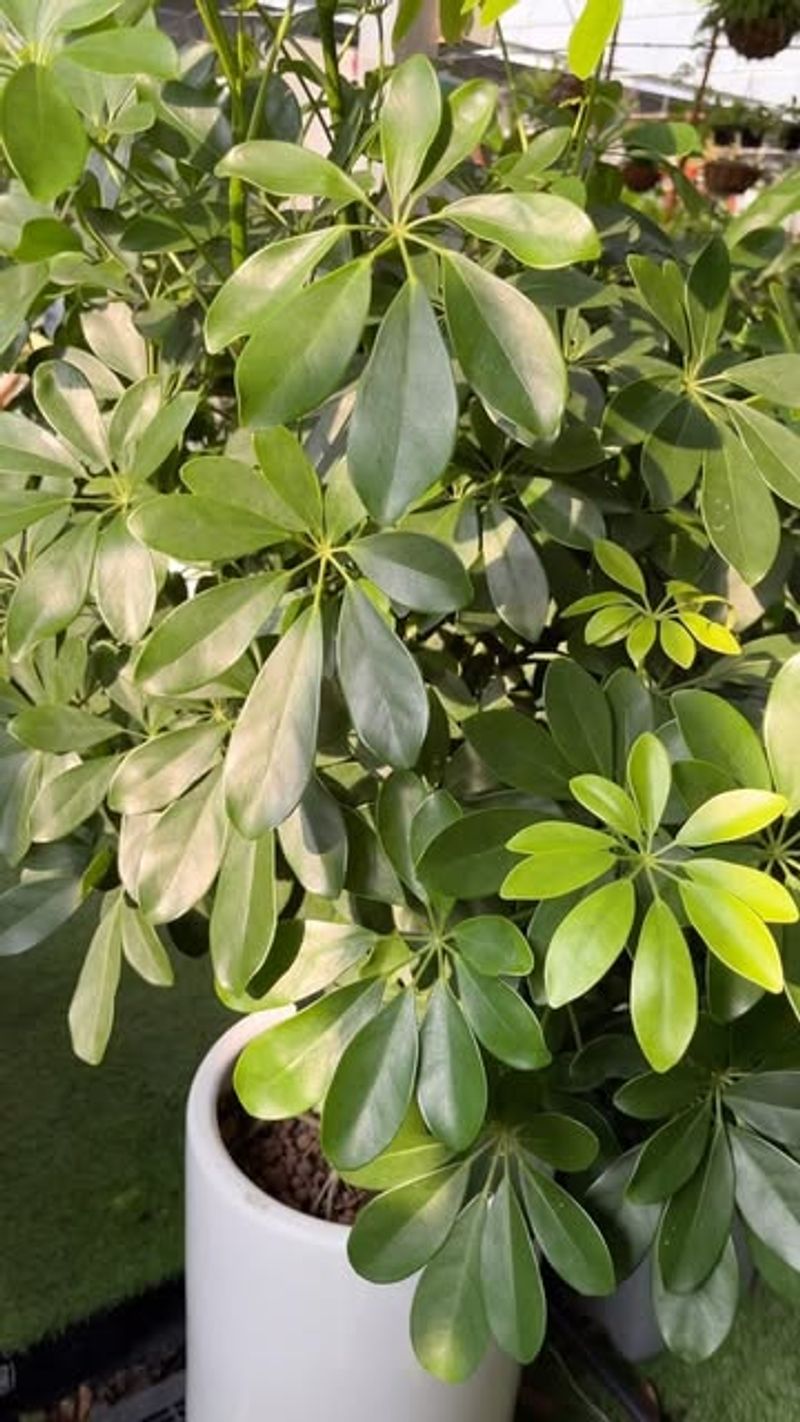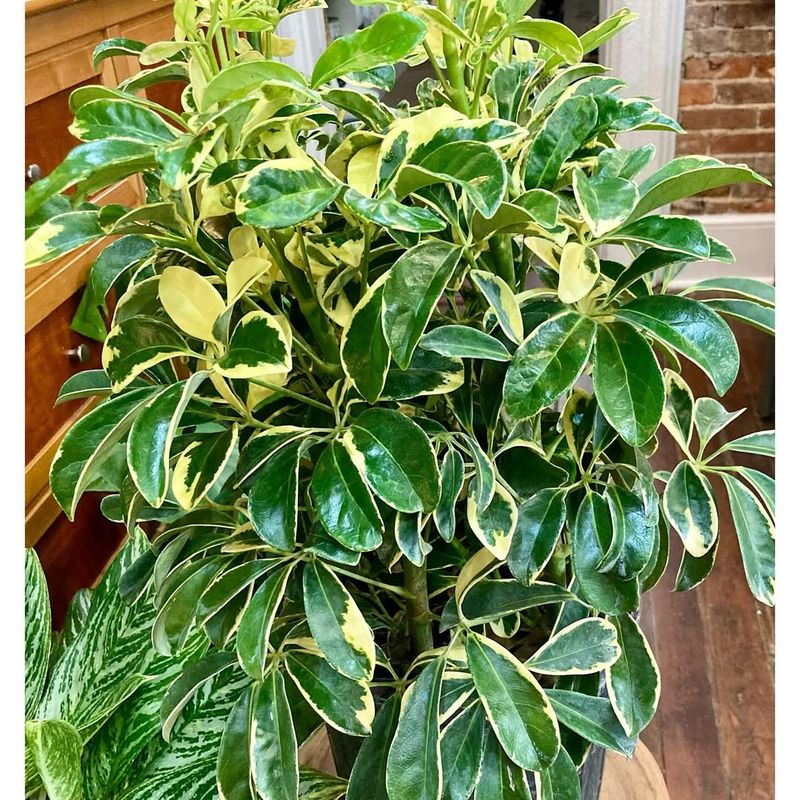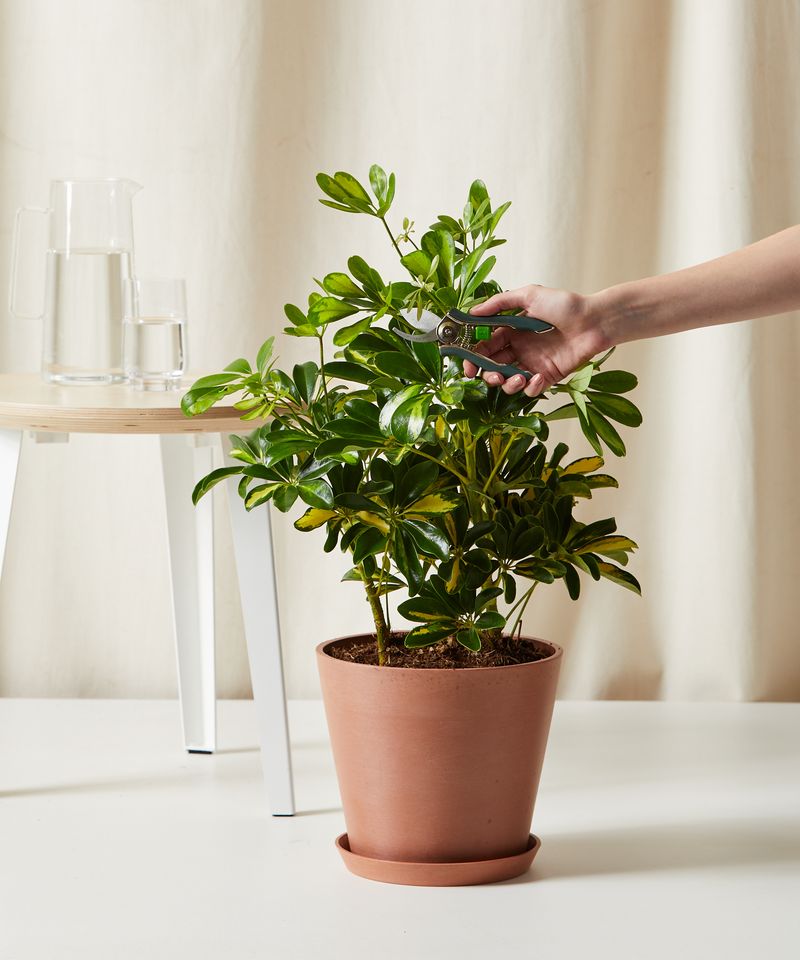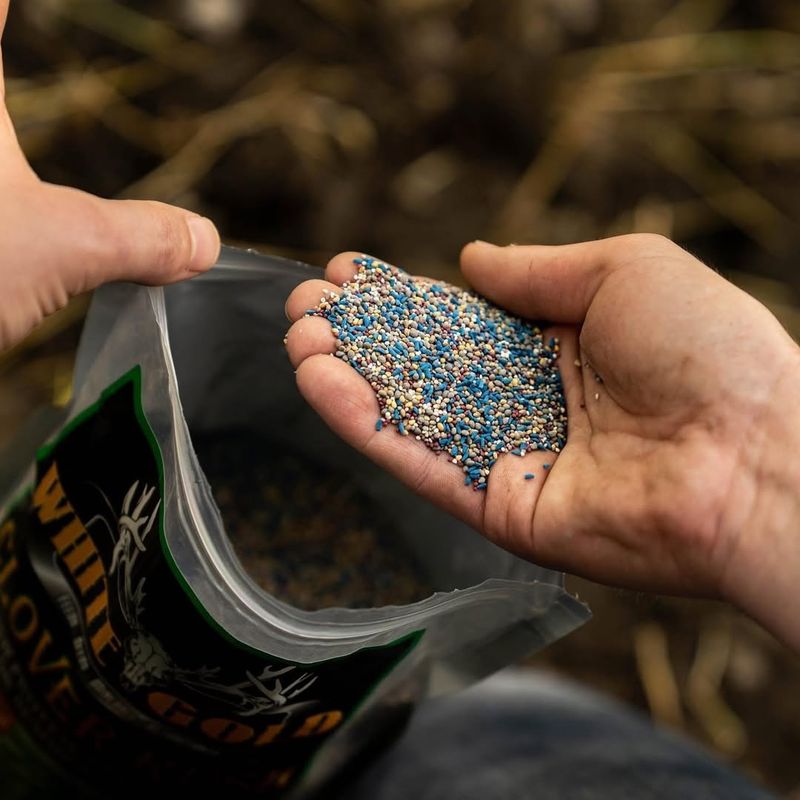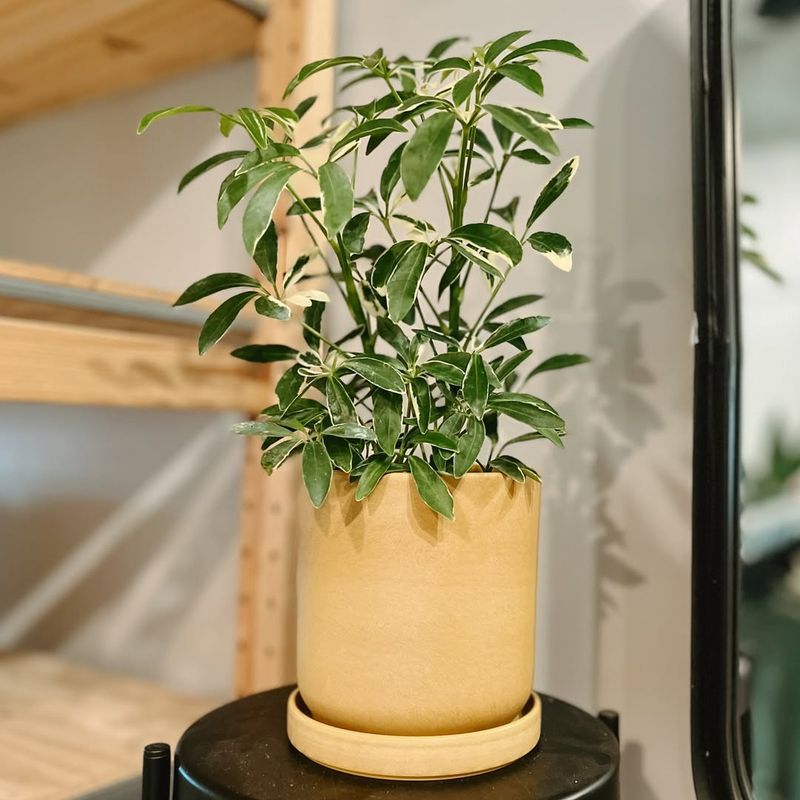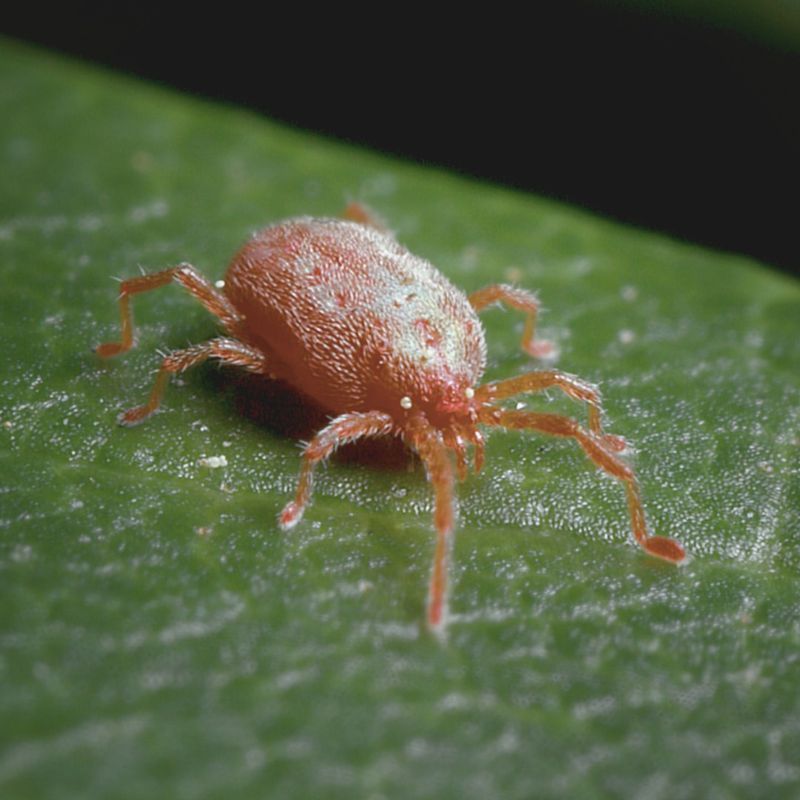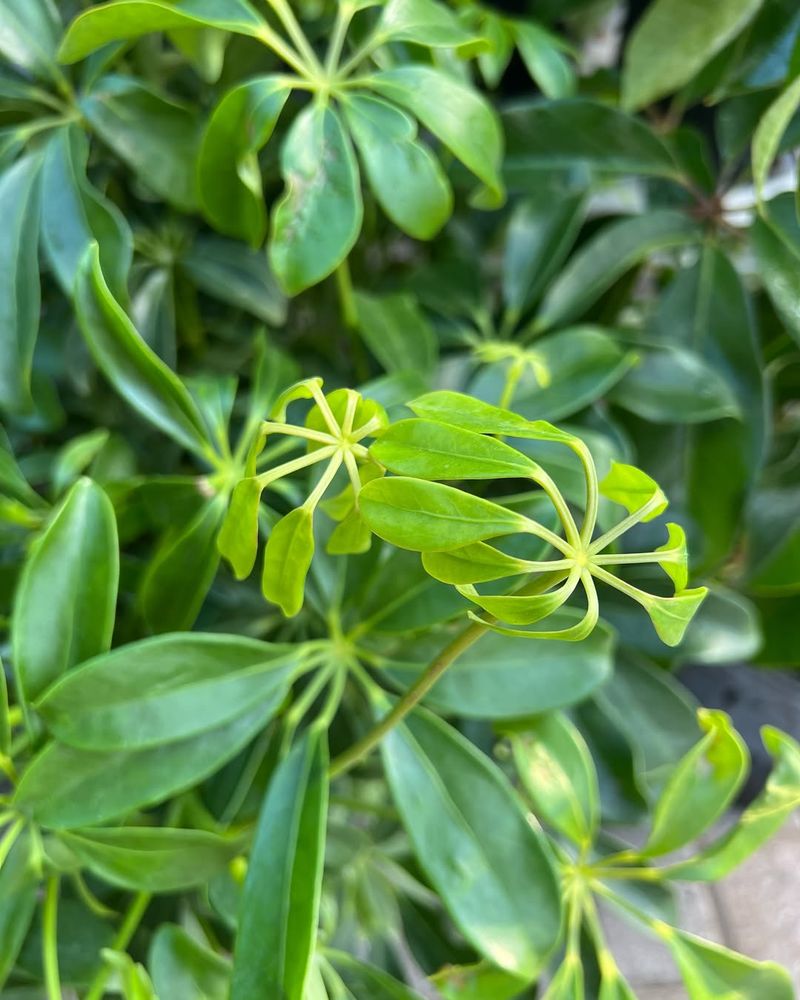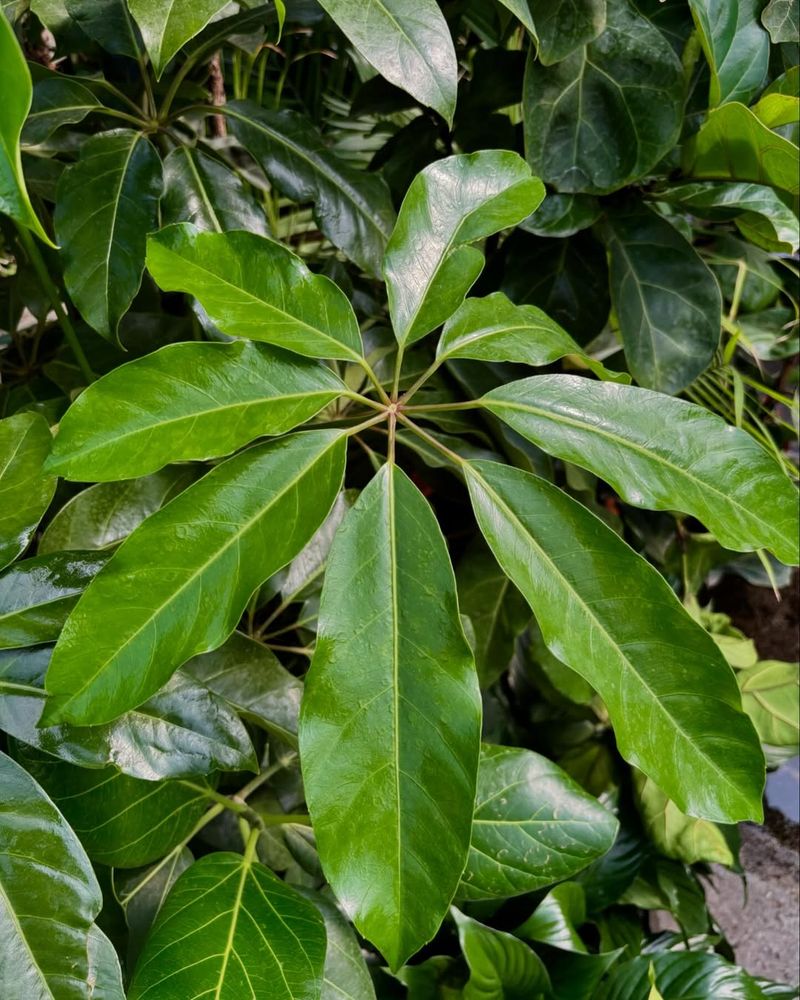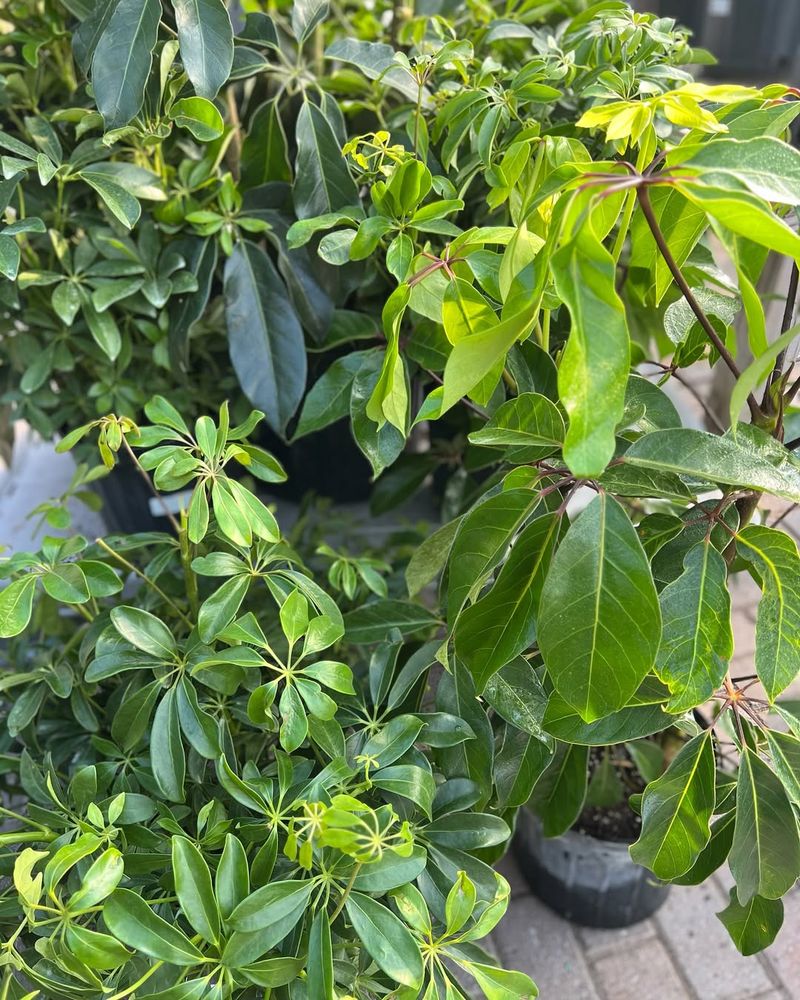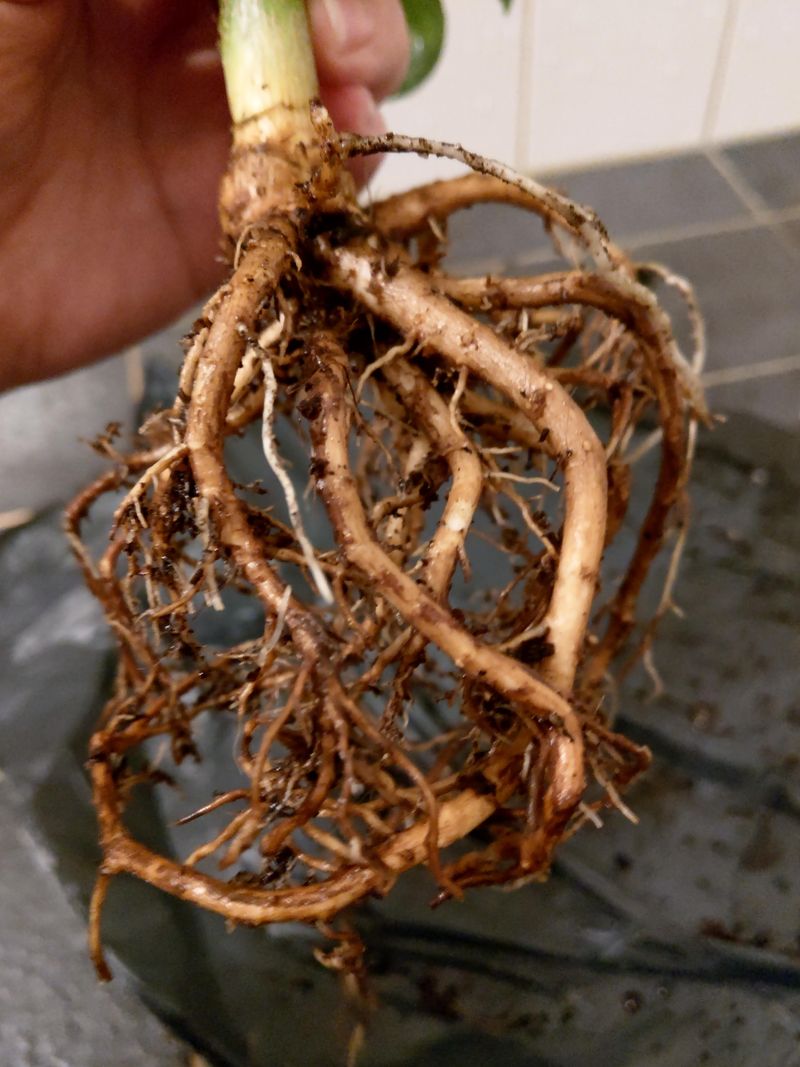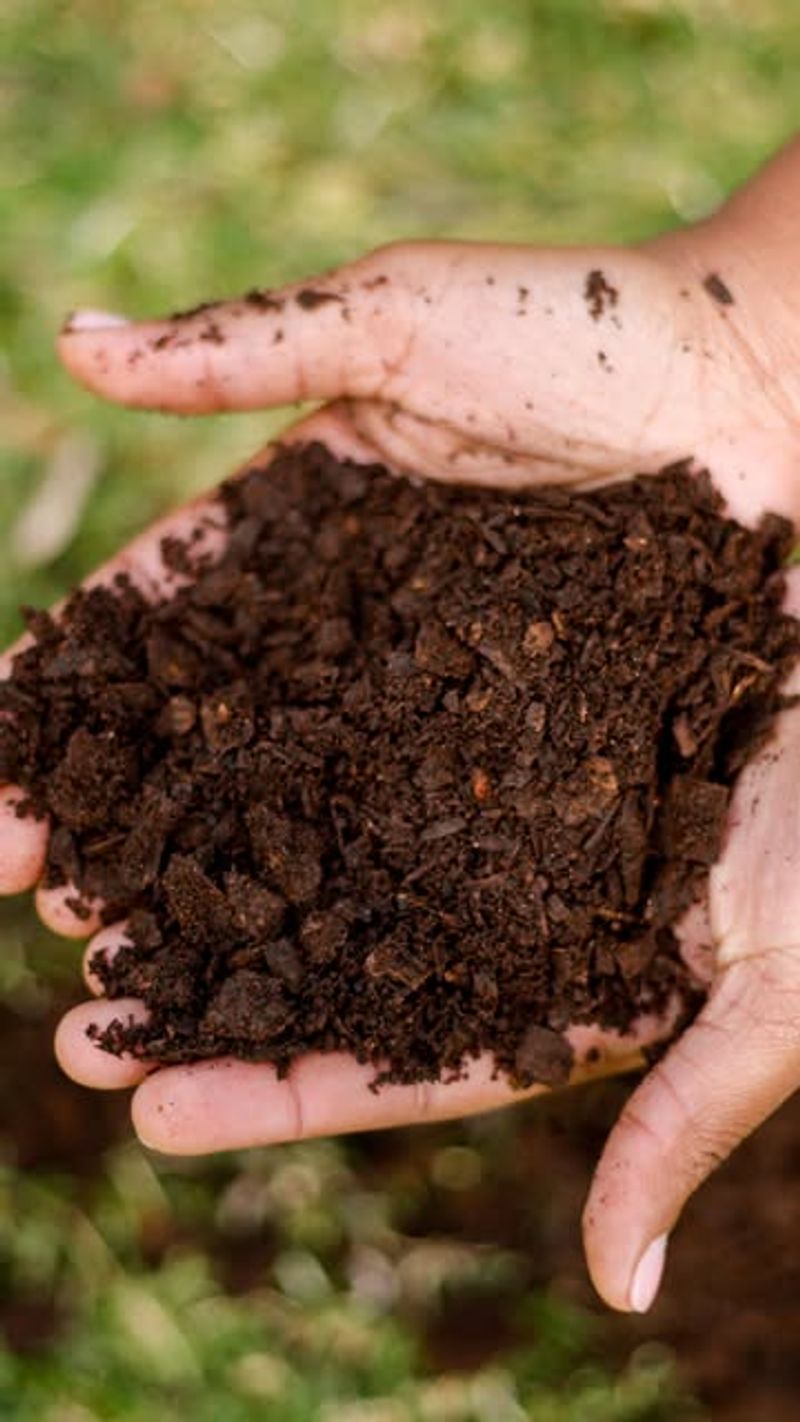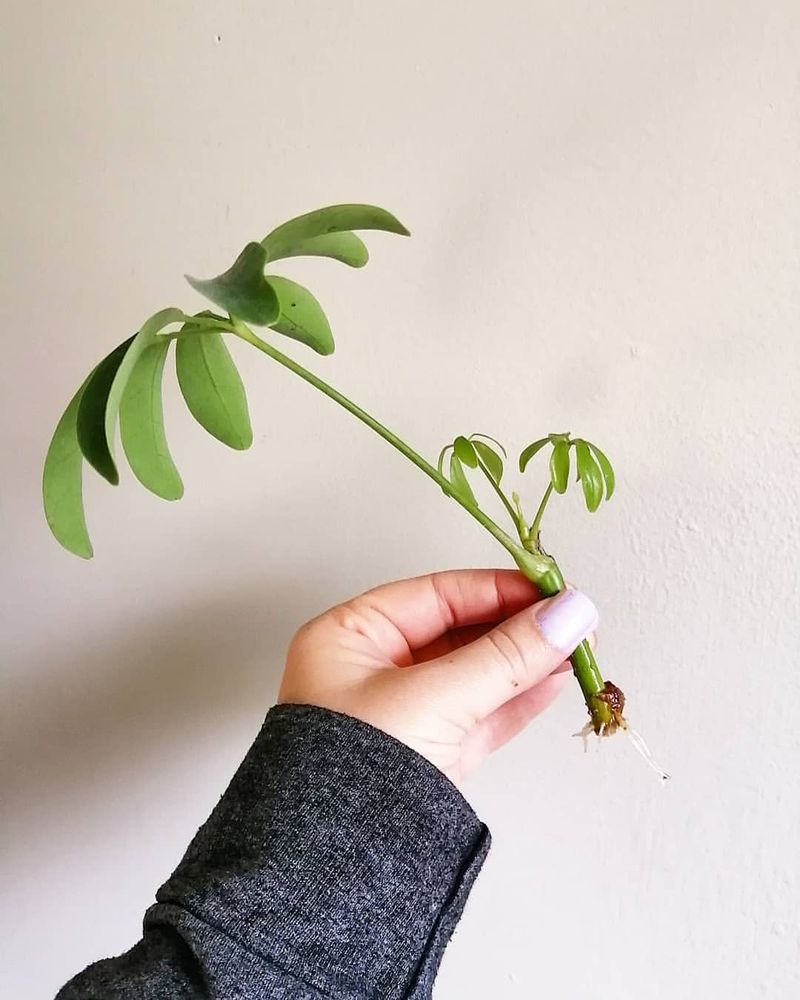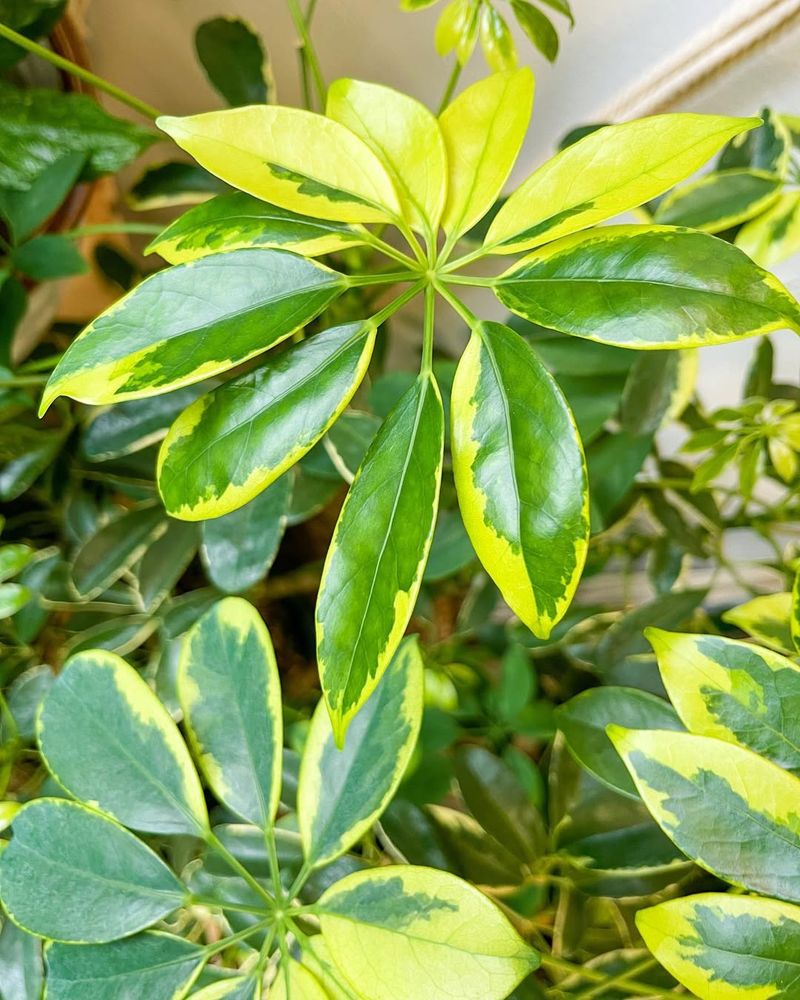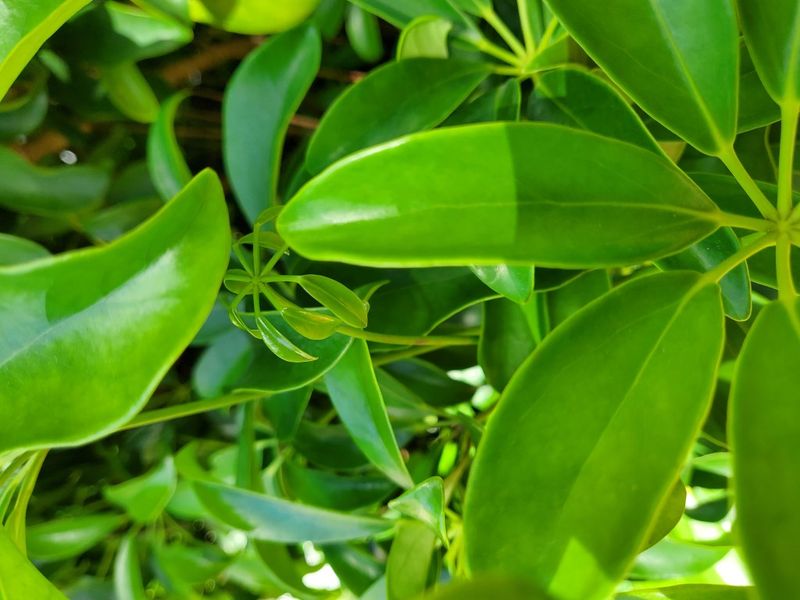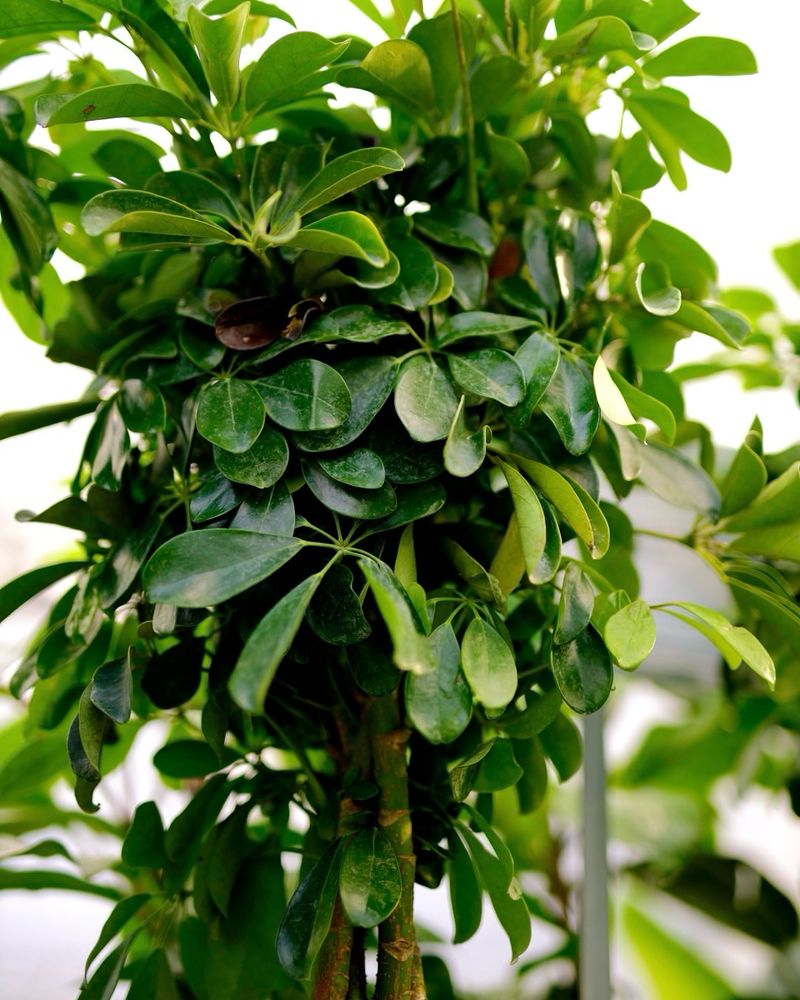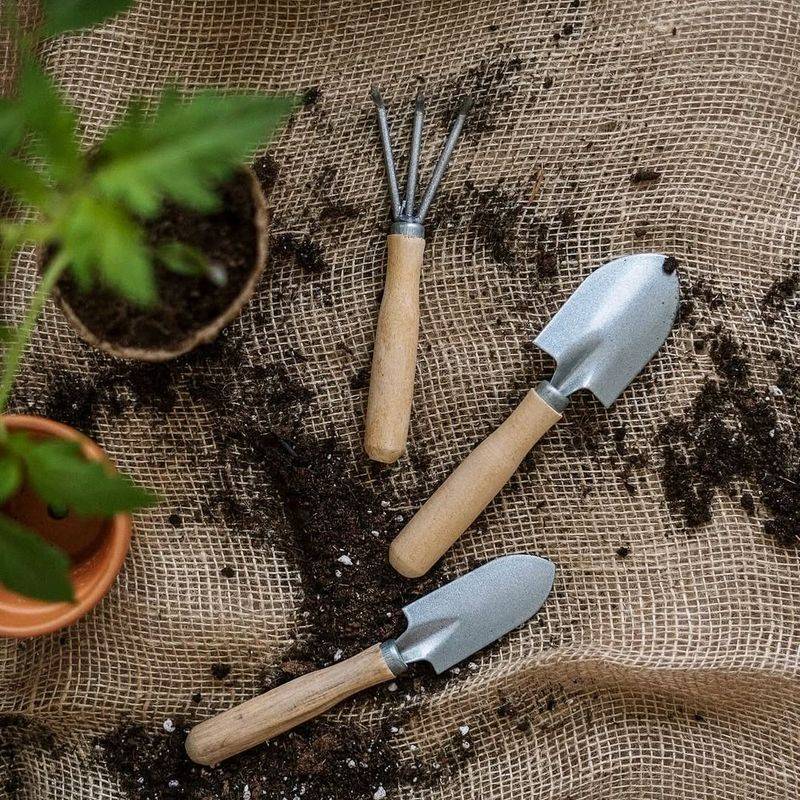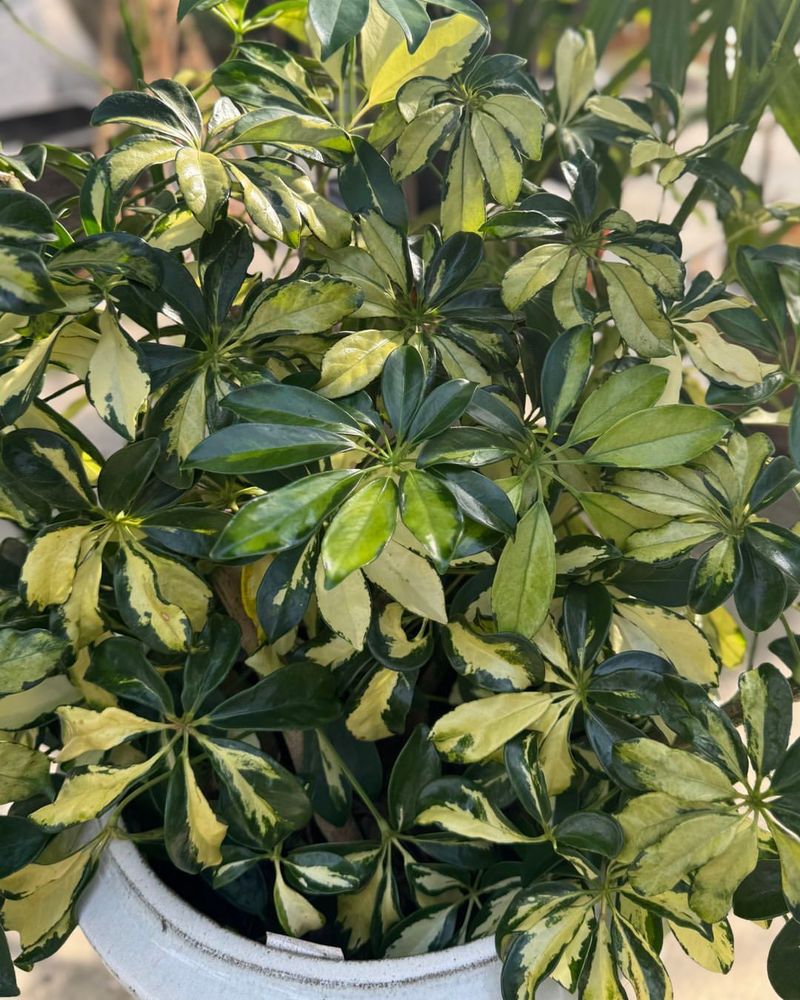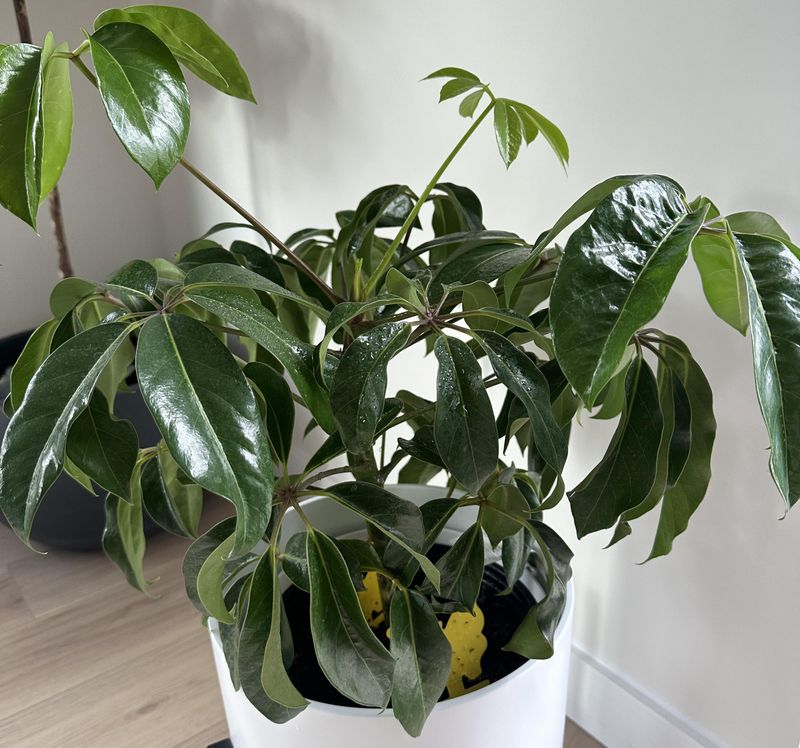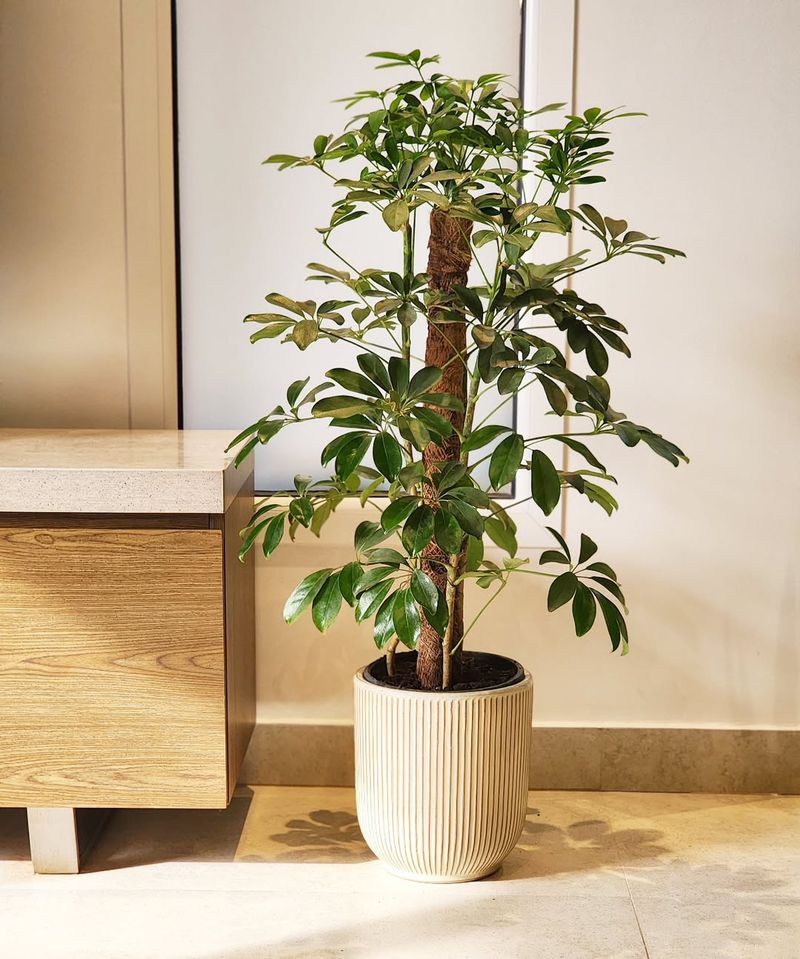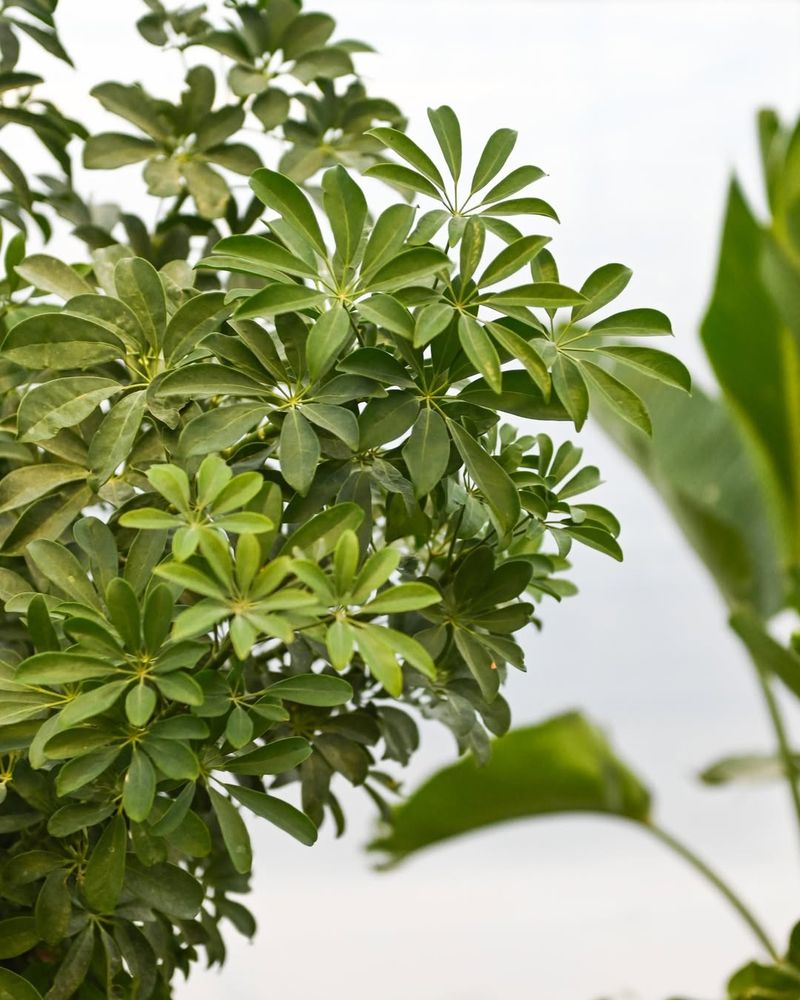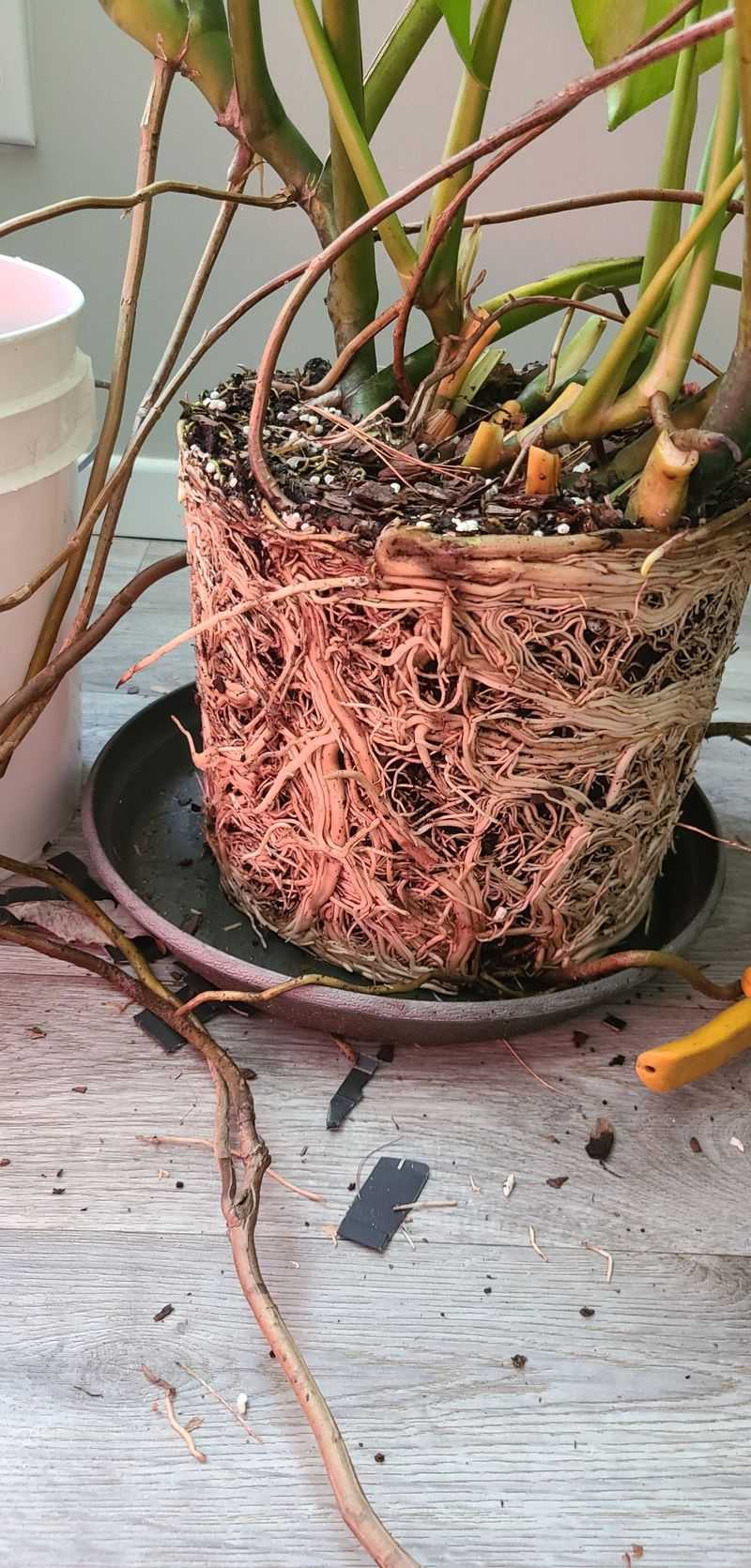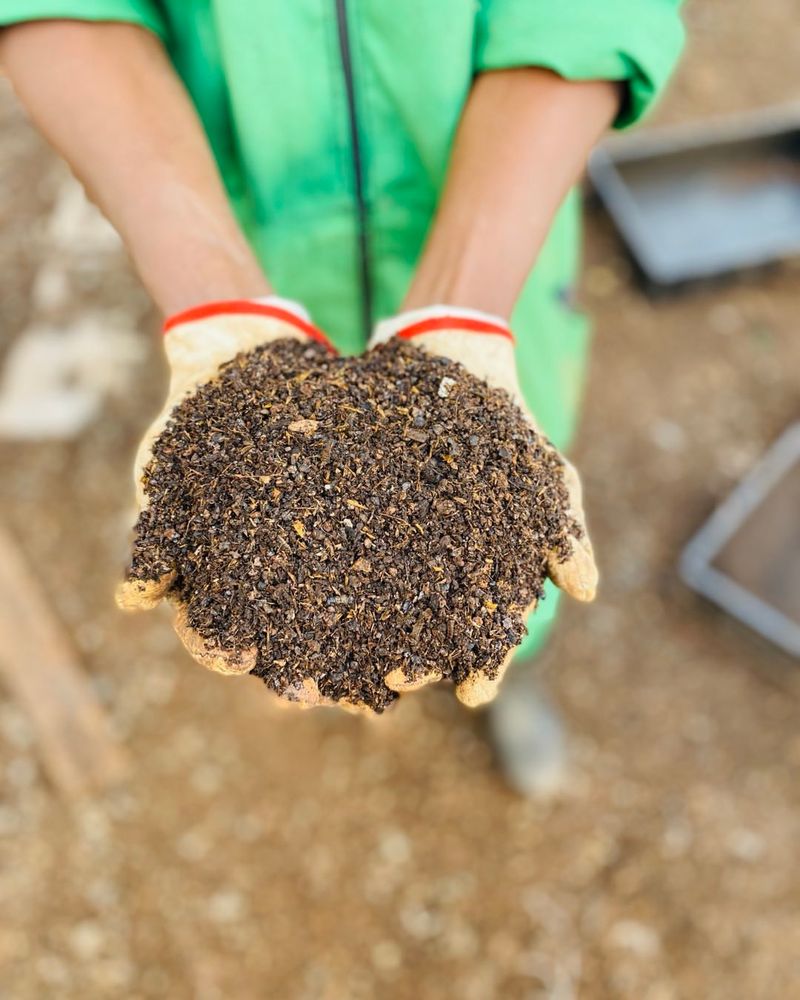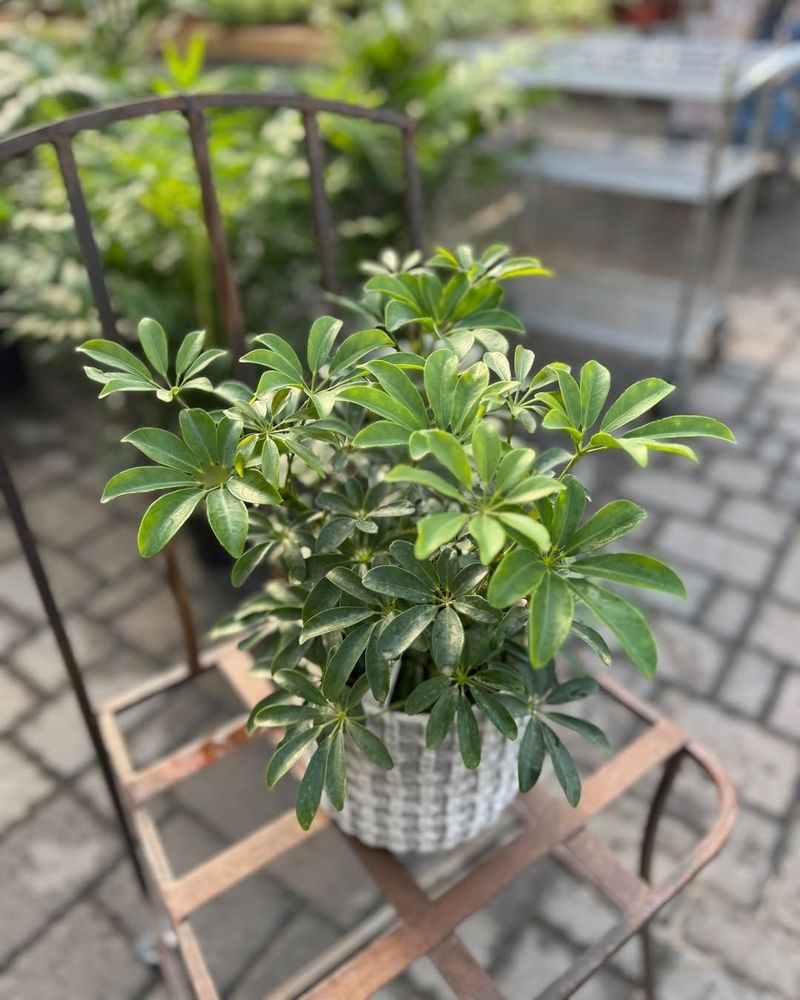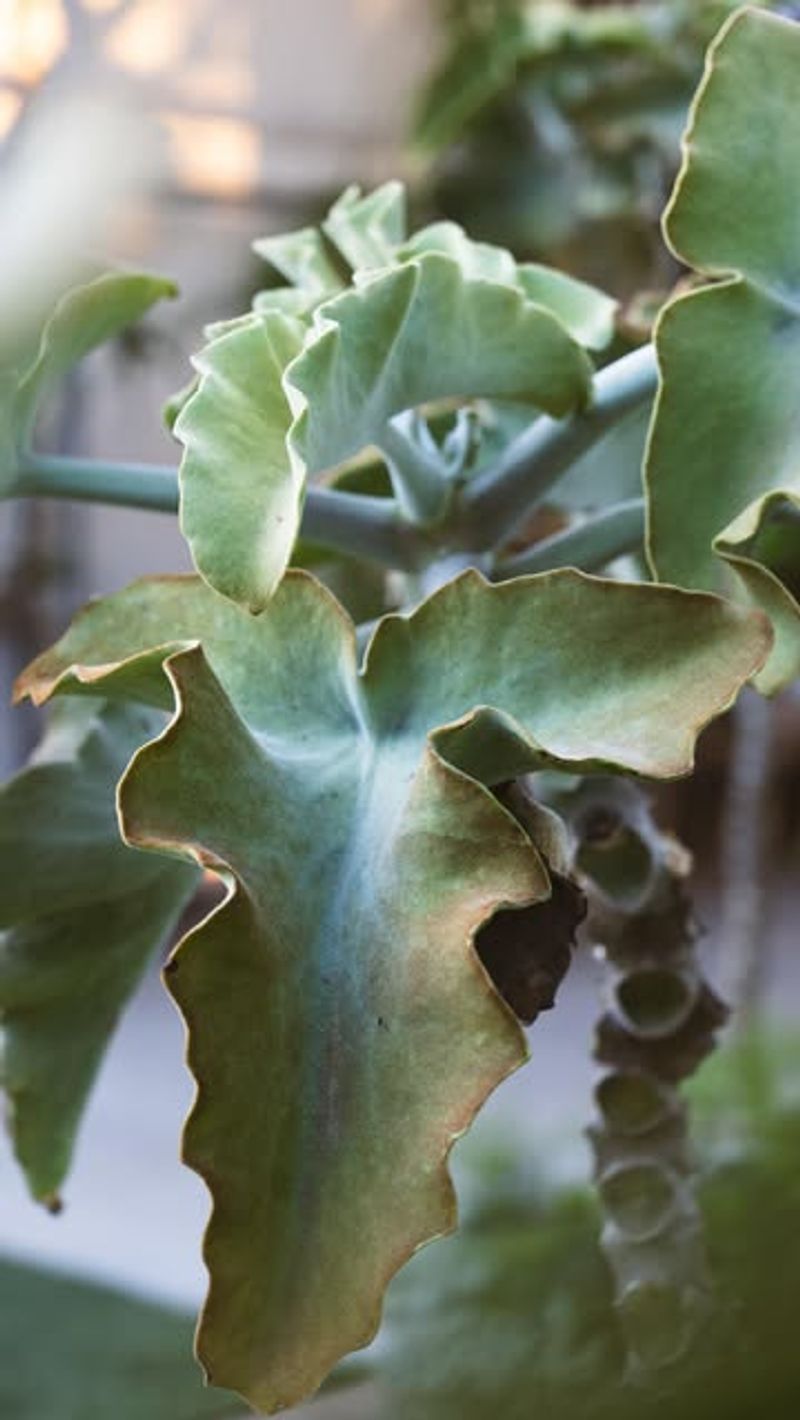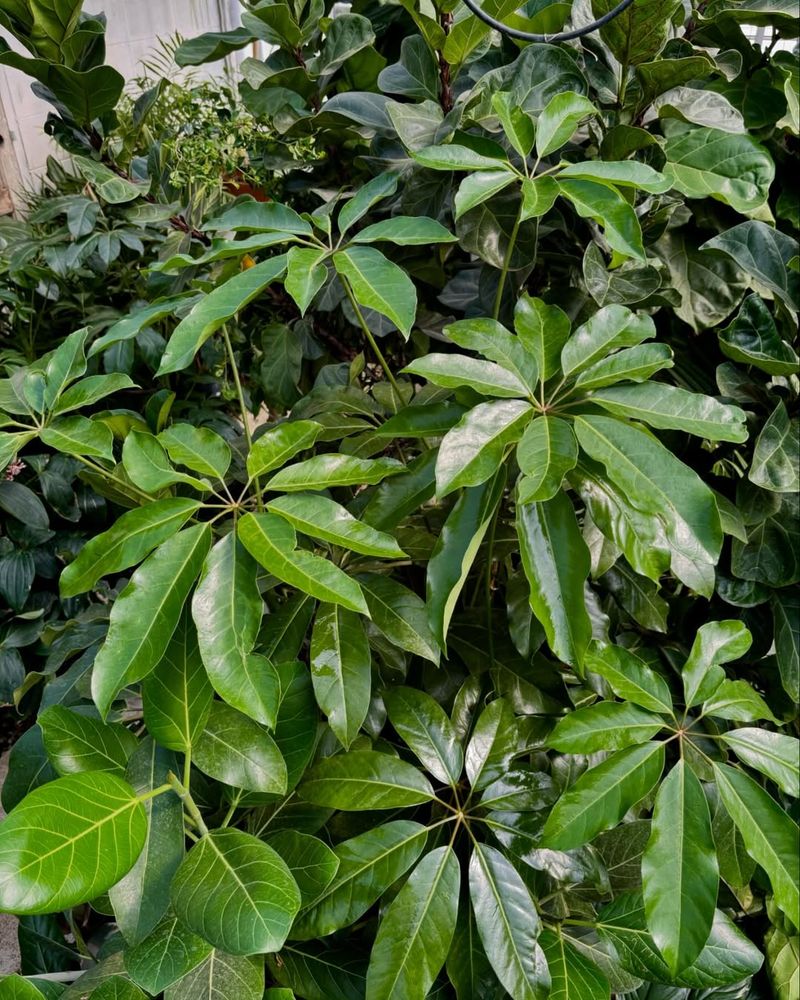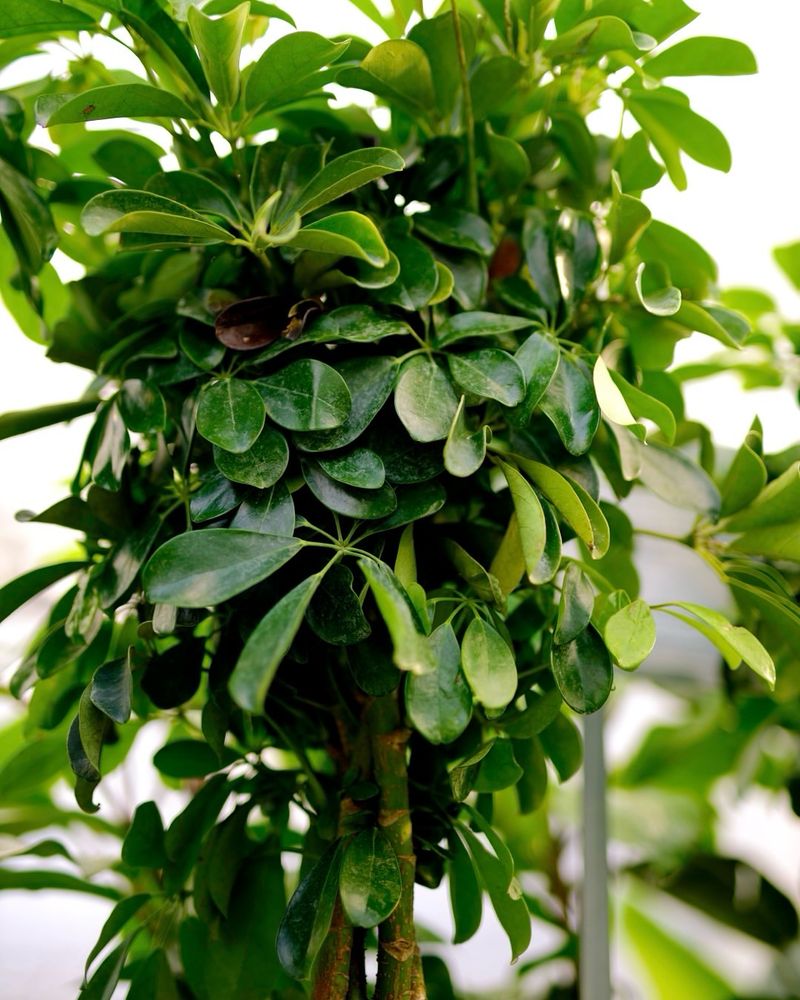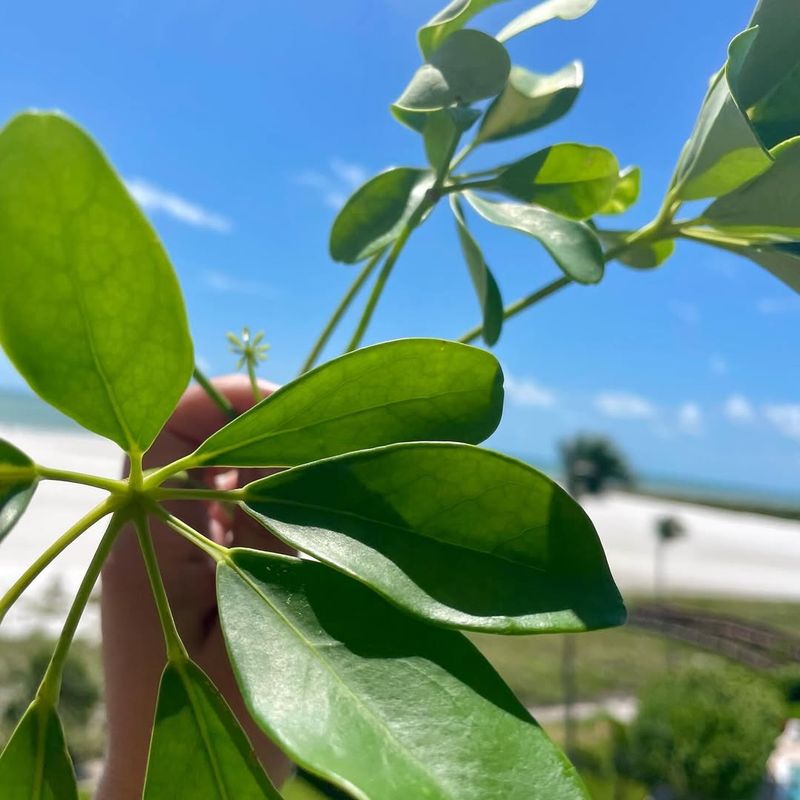Caring for your Schefflera plant doesn’t have to feel like a chore. With the right approach, it can be one of the easiest plants to keep happy. Get the watering, light, and pruning just right, and it’ll reward you with strong, glossy leaves and steady growth.
These 25 ways will help you keep your Schefflera thriving while avoiding common mistakes that can lead to yellowing leaves or slow growth. Plus, some essential steps to keep it growing strong and looking fresh all year long.
1. Proper Lighting
Sunshine is the best kind of love! Your plant will appreciate indirect sunlight. Scheffleras thrive when positioned near a window where they can enjoy bright but indirect light. Avoid the harsh direct rays of the sun, which can scorch its leaves.
Check the leaves regularly—if they’re turning yellow, your plant might be getting too much sun. On the flip side, sparse growth could indicate a need for more light. Adjust the plant’s location gradually, allowing it to acclimate to new conditions. Finding the perfect light balance is key for healthy growth.
2. Water Wisely
Less is more! The key to watering your plant is moderation. Schefflera loves well-drained soil that isn’t soggy. Wait until the top inch of the soil is dry before reaching for the watering can. Overwatering is a common mistake, leading to root rot.
Check the soil moisture weekly, especially during the growing season. In winter, reduce the watering frequency, as the plant’s needs decrease. Consistency is crucial, so try to stick with a schedule. But remember, it’s always better to err on the side of dryness than to drown your leafy friend.
3. Humidity Levels
Feeling dry? Your plant might be, too! Scheffleras love a humid environment. If your home is dry, especially in winter, consider misting the leaves regularly. Alternatively, placing a humidifier nearby or setting the plant on a pebble tray with water can help maintain the necessary moisture.
Watch out for crispy leaf edges, which can signal low humidity. Keeping the air around your plant moist helps it thrive and keeps the foliage lush. Embrace a little humidity for a happier plant life!
4. Balanced Feeding
Time for some food! Fertilize your plant during the growing season with a balanced liquid fertilizer. Feeding should be done every couple of weeks from spring through early fall. Avoid fertilizing in winter when the plant is resting.
Over-fertilization can harm your plant, causing leaf burn or rapid, weak growth. Always follow the instructions on your fertilizer bottle and consider diluting it for a gentler feed. Regular, balanced feeding leads to strong, vibrant growth, ensuring your plant looks its best all year round.
5. Pruning Techniques
Time to trim! Pruning helps your plant stay healthy and shapely. Use clean, sharp shears to trim any dead or diseased leaves. Regular cutting back encourages bushier growth and prevents a leggy appearance. Make cuts just above a leaf node to stimulate new growth.
Don’t be afraid to prune—it helps rejuvenate your plant. Remove any leaves that look tired or worn out. With a little snip here and there, your Schefflera will stay in top form, looking neat and tidy!
6. Repotting Needs
Growing bigger! Your plant may outgrow its pot every couple of years. Look for roots growing out of the drainage holes—this is a sign it’s time to repot. Choose a pot one size larger with good drainage, and use fresh potting mix.
Gently remove the plant from its old pot, shake off excess soil, and place it in the new pot. Water thoroughly after repotting to help settle the soil. Repotting invigorates your plant, giving roots space to expand and helping it continue to thrive.
7. Pest Control
Bugs, begone! Keep an eye out for pests like spider mites and aphids. Inspect the leaves regularly, especially the undersides, where these tiny intruders love to hide. If pests are spotted, remove them with a gentle spray of water or a soft cloth.
For more stubborn infestations, consider using insecticidal soap. Early detection is key to keeping your plant healthy. Regular monitoring and quick action can prevent pests from taking over, ensuring your Schefflera stays pest-free and lively.
8. Temperature Tolerance
Keep it cozy! Scheffleras prefer a stable environment. They thrive in temperatures between 60-75°F (15-24°C). Avoid placing your plant near drafts, heaters, or air conditioners, as sudden temperature changes can stress it.
If the leaves start to drop or look stressed, check for temperature fluctuations. Maintaining a consistent environment helps your plant stay healthy and happy, ensuring it grows strong and beautiful.
9. Leaf Care
Shine on! Dust can accumulate on leaves, affecting photosynthesis. Use a damp cloth to gently wipe the leaves, keeping them clean and glossy. This not only improves their appearance but also boosts the plant’s health by allowing maximum light absorption.
Make it a part of your routine every few weeks. Pay attention to each leaf, ensuring you don’t miss any spots. Cleanliness contributes to a thriving plant, helping it glow with vitality.
10. Seasonal Adjustments
As daylight hours vary, your Schefflera’s needs will shift. In winter, move it closer to windows to capture more light. Adjust watering and feeding schedules to match the plant’s seasonal rhythms.
Less water and no fertilizer during winter dormancy helps the plant rest. Be observant and responsive to these changes, adapting care as necessary. Seasonal adjustments ensure your plant remains healthy and robust throughout the year.
11. Root Health
What lies beneath is just as important! Healthy roots are the foundation of a thriving plant. During repotting, check for firm, white roots. If you encounter dark, mushy roots, trim them away to prevent rot.
Ensure the new potting soil allows for proper drainage to keep the roots oxygenated. Regular root inspections can prevent unnoticed issues from escalating. Happy roots lead to a happy plant, supporting lush above-ground growth.
12. Soil Choice
Get grounded! The right soil can make all the difference. Scheffleras thrive in well-draining potting mix. Choose a blend that retains some moisture but doesn’t stay soggy. Adding perlite or sand can improve drainage, which is crucial for root health.
Avoid heavy, compacted soils, which can suffocate roots. A light, airy mix supports robust growth and reduces the risk of root rot. Healthy soil equals a healthy, flourishing plant.
13. Propagation Fun
Grow your own! Propagating your Schefflera can be an exciting way to expand your plant collection. Take stem cuttings with at least a couple of leaves during the growing season. Place them in water or soil and keep them in a warm, bright spot.
Patience is key as roots develop over a few weeks. Propagation can be a rewarding experience, allowing you to share your love of plants with friends or simply add more greenery to your own space.
14. Avoid Overcrowding
Need some space? Your plant does too! Overcrowding can lead to poor air circulation and light deprivation. Ensure each Schefflera has ample space to grow and spread its leaves. This helps minimize the risk of mold and disease.
Think of it as social distancing for plants—a little space goes a long way in promoting healthy growth and vibrant foliage. Give your plant room to breathe, and it’ll thank you with lush development.
15. Dealing with Yellow Leaves
Houston, we have a yellow leaf! But fear not, it’s a common issue. Yellowing can result from overwatering, poor lighting, or nutrient deficiencies. First, check your watering habits—too much or too little can both cause yellowing.
Next, assess the light situation and adjust as needed. If lighting and watering aren’t the culprits, a lack of nutrients might be. Consider a gentle feed to perk things up. Identifying and addressing the cause helps get your plant back to its vibrant self.
16. Understanding Dormancy
Winter is coming, and your plant feels it too. Schefflera enters dormancy during the colder months, conserving energy. During this time, its growth slows, and it requires less water and no fertilizer. Allow it to rest by keeping it in a slightly cooler, well-lit spot.
Understanding this natural cycle helps you adjust your care routine, ensuring the plant awakens in spring ready to grow. Embrace the downtime—it’s all part of the plant’s rhythm.
17. Check for Leggy Growth
Stretching too much? Your plant might be seeking more light. Leggy growth occurs when a Schefflera stretches towards light sources. If you notice long, sparse stems, consider moving the plant to a brighter location. Pruning can also help by encouraging bushier growth.
Regularly rotating the plant ensures even light exposure, promoting balanced development. Keeping an eye on growth patterns and making adjustments keeps your plant compact and lush.
18. Using the Right Tools
Tools of the trade make all the difference. Using sharp, clean tools ensures precise cuts and minimizes the risk of disease. Invest in quality gardening shears and gloves to protect your hands and the plant.
Clean tools between uses to maintain plant health. Proper tools not only make the job easier but also keep your plant happier and healthier. It’s like having the right dance shoes—everything flows better.
19. Signs of Over-fertilizing
Too much of a good thing? Over-fertilization can lead to leaf burn and stunted growth. Watch for signs like brown leaf tips or crusty deposits on the soil. If you suspect over-fertilizing, flush the soil with clean water to remove excess salts.
Adjust your feeding schedule and consider diluting the fertilizer in the future. Understanding these signs helps prevent damage and ensures your plant receives just the right amount of nutrients to thrive.
20. Creating a Routine
Consistency is your best friend! Establishing a care routine helps your plant flourish. Set reminders for watering, feeding, and checking for pests or problems. Adjust the routine as needed, based on seasonal changes and the plant’s condition.
This ensures you’re not overlooking any aspect of care. Just like any good habit, a little regular attention goes a long way in promoting a healthy, thriving Schefflera. It’s all about finding a rhythm that works.
21. Handling Pot Size
Size matters, especially when it comes to pots. A pot that’s too large can retain excess moisture, while a too-small pot restricts growth. Choose a pot that matches your Schefflera’s current size and growth rate.
Ensure it has drainage holes to prevent waterlogging. Monitoring the plant’s growth and adjusting the pot size accordingly supports healthy root development and overall vigor. It’s like Goldilocks—finding the size that’s just right.
22. Understanding Leaf Drop
Leaves on the ground? Don’t panic—some leaf drop is normal, especially as old leaves make way for new growth. However, sudden or excessive leaf drop can signal stress from overwatering, temperature changes, or pest issues.
Investigate the cause and adjust care practices accordingly. Understanding leaf drop helps differentiate between normal growth and potential problems, ensuring your plant stays vibrant and healthy.
23. Avoiding Cold Drafts
Brrr, it’s cold out there! Protect your plant from cold drafts, which can cause leaf drop and stress. Keep it away from open windows, doors, and other drafty areas. If you feel a chill, your plant probably does too.
Maintaining a stable, warm environment helps it thrive, keeping its leaves lush and green. Cozy surroundings make for a happy, healthy Schefflera.
24. Using Natural Insect Repellents
Bugs not welcome! Natural insect repellents can keep pests at bay without harsh chemicals. Try neem oil, a gentle and effective option. Mix it with water and spray the plant, focusing on the undersides of leaves.
Reapply as needed, especially if pests are persistent. Using natural solutions keeps your plant and home environment safe and healthy. It’s like giving your plant a gentle, protective hug.
25. Checking for Root Bound
Feeling cramped? Your plant might be root-bound if the roots circle the pot or grow out of drainage holes. Gently remove the plant from its pot to inspect the roots. If they’re tightly packed, it’s time to repot into a larger container with fresh soil.
Addressing root-bound conditions allows roots to spread and absorb nutrients more efficiently, supporting robust growth. It’s like giving your plant a new lease on life.
26. Preventing Nutrient Deficiency
Looking a little pale? Nutrient deficiency can cause discolored leaves and poor growth. Ensure your plant receives a balanced diet of nutrients. Regularly apply a complete, balanced fertilizer during the growing season.
Monitor the plant for signs of deficiencies, such as yellowing or stunted growth. Addressing nutrient needs promotes lush, vigorous growth and keeps your plant looking its best. A well-fed Schefflera is a happy Schefflera.
27. Monitoring Growth Patterns
Growing a little lopsided? Monitoring growth patterns helps keep your plant symmetrical and balanced. Rotate the pot every few weeks to ensure even light exposure and prevent uneven growth. This simple step encourages a full, lush appearance.
Observing how your plant reacts to its environment provides insights into its health and needs. Balanced growth leads to a visually pleasing and healthy Schefflera.
28. Avoiding Overwatering
Splash zone alert! Overwatering is a common pitfall. Always check soil moisture before watering—stick a finger in an inch deep. If it feels dry, it’s time to water; if not, hold off. Overwatering can lead to root rot and other issues.
Developing a watering routine based on observation rather than a set schedule helps prevent this. A little attention goes a long way in nurturing a healthy, thriving plant.
29. Encouraging Air Circulation
Breathe easy, plant! Good air circulation prevents mold and disease. Place your Schefflera in a spot where it’s not crowded by other plants or furniture. Ensure there’s good airflow around it, especially if you notice any moldy or damp smells.
This helps the plant ‘breathe’ better, promoting healthy growth and reducing the risk of disease. A little space and some fresh air make for a happy plant life.
30. Utilizing Support Stakes
Lean on me! Support stakes can help your Schefflera grow upright, especially if it’s top-heavy or leggy. Insert a bamboo or wooden stake into the soil, and gently tie the plant to it with soft ties. This encourages strong, vertical growth.
Support helps prevent breakage and keeps your plant looking tidy. It’s like giving your plant a sturdy backbone, ensuring it stands tall and proud.
31. Regular Inspections
Check it out regularly! Frequent inspections help catch problems early. Look for signs of pests, disease, or stress like yellow leaves or unusual growth patterns. Early detection means you can address issues promptly, preventing them from escalating.
Make inspections a routine part of your plant care. This proactive approach keeps your plant healthy and thriving. After all, a little attention often can save a lot of trouble later on.

